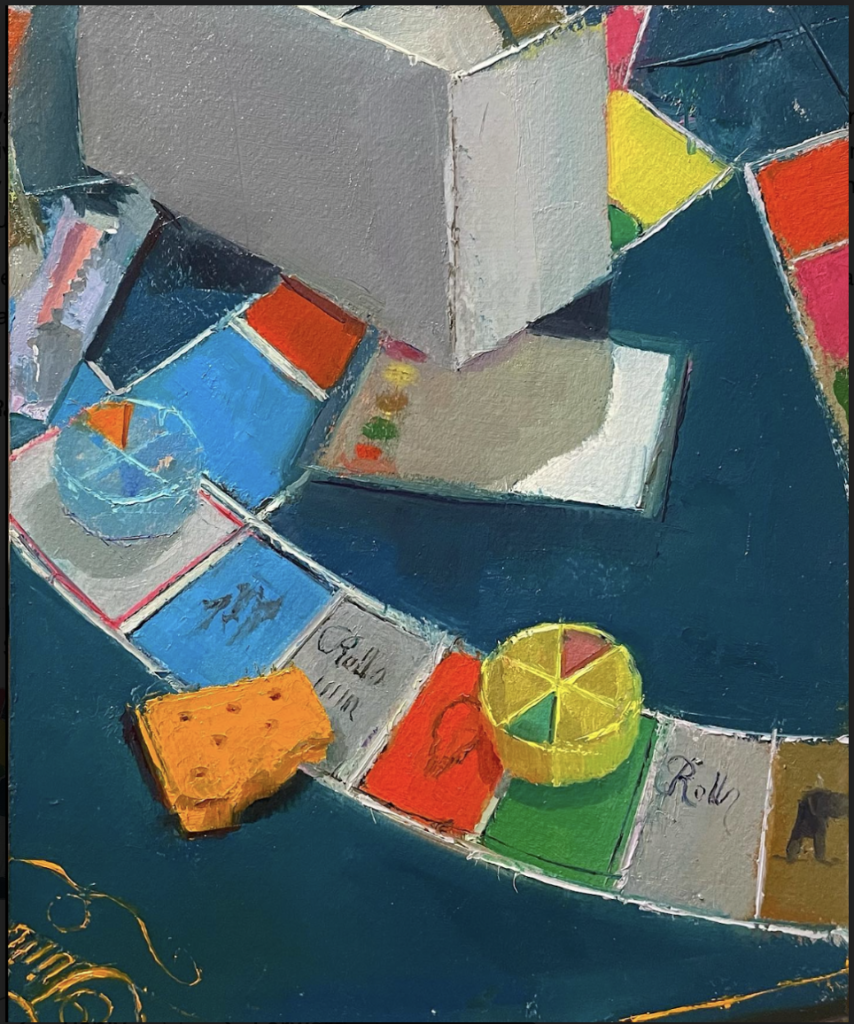Innocent delights at Exeter Gallery

Erin Raedeke, Trivial Pursuit, 10” x 8”, oil on panel.
I’ve been returning to Erin Raedeke’s paintings with pleasure over the past decades. What first intrigued me were her perfectly composed images of what appeared to be detritus from a child’s birthday party. Getting what looked like perfect compositions from a post-party mess was an achievement in itself. Yet her color carried most of the charm. She hasn’t posted any of that uniquely lovely work from a decade ago at her website. I wonder if she thinks they’re too pretty. That’s how Matt Klos referred to them when we were discussing her paintings, after he’d included her work in his curation of a show of perceptual painters in Baltimore. (On my last trip to New York City, Steve Daimant at Arcadia Gallery talked about how he looked for work that was beautiful but not pretty, so pretty is pejorative. Got it. I’ve always thought Matisse cut-outs are pretty great, as well as just pretty, but maybe I’m wrong.)
Some of her more recent still life images come close to those after-party paintings: looking down at a flat surface, objects randomly strewn into view, everything forming an abstract pattern from top to bottom and side to side, with little or no negative space, just a solid patchwork of one thing astride another or sharing adjacent space, everything falling into place randomly as the playmates leave their mess behind. The birthday paintings were haunting, charming, beautiful, with colors perfectly chosen—her sense of color in the best work is extremely good, purely musical—and a little sad, given that we are loitering around after the party has ended, glimpsing the beauty the celebrants left by accident. Go even further back and some of her landscapes from 2006 and 2007 are marvelous village scenes that could be from nearly any little burg or ‘burb in the hilly Northeast. As I’ve written here in a post years ago, Backyard Gardens is a perfect painting, reminding me of the simplified precision of the late Fairfield Porter at his best. My favorite Porters are the ones that I’m certain he did from photographs, keeping his simplified approach to representation, one patch of color next to another, accurate in terms of shape and form but more concerned with light and color than detail, and this painting has that same quality. Her color sense in these outdoor scenes—intensely evocative of a certain kind of light at a given time of day—are quite different from the still life work, but just as carefully felt in the way the colors work together. They aren’t there just to trick the eye or drafted into service as a way of creating a sense of depth or volume or whatever–each color is there for its own sake, along with what it’s doing for the others around it. It’s hard to describe how her color distinguishes itself from so many of her fellow perceptual painters. Her tones, in absolute terms, can be just as muted, but they harmonize and accentuate one another and come together in a way that sometimes sings–not always but often–and has a quality of nostalgic yearning: she feels her images into being with these tones. Her recurrent affinity for humble and common subject matter most painters would think unworthy of attention, often related to childhood—board games, party hats, jelly beans, snacks, Froot Loops turning to junket in a bowl, as Robert Lowell would have put it—it reminds me of Pop’s friendly, unpretentious and anti-heroic attention to everyday things, simple food, household products, things so familiar you don’t even see them when they’re there, inanimate companions everyone takes for granted, domestic objects Chardin might have painted if he’d had a dozen things from the past fifty years shipped back to his era.
You can see Raedeke’s latest work at Exeter Gallery’s current show “Generations.” You can get a preview of the Gen X Series at her site. It’s being shown along with work from Neil Callander and Nicole McCormick Santiago. As Matt Klos writes about the work of all three: “The art in Generations explores youthful memories, present hardships and enjoyments, parenthood, and a look toward the future with soberness and sincerity.” I would say in Raedeke’s work, it’s a mood of poignant joy, a wistful quiet glimpse of innocence, past and yet fully present.
Comments are currently closed.